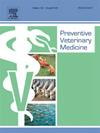A model-based approach to evaluate the effect of vaccination of the herd on transmission of equine herpesvirus 1 in naturally occurring outbreaks
IF 2.2
2区 农林科学
Q1 VETERINARY SCIENCES
引用次数: 0
Abstract
Equine herpesvirus 1 (EHV-1) infection is the cause of high impact disease syndromes, affecting the global horse industry. The effect of vaccination on transmission dynamics of EHV-1 in naturally occurring outbreaks is not quantified. Our aims were to estimate R0 for EHV-1 in equine populations from outbreak data, and evaluate the effect of vaccination status of the herd on R through a systematic review, model-based estimations and meta-analysis. A literature search for outbreak reports was carried out. Depending on available data, the early epidemic growth rate (GR) or final attack rate (AR) approach was used to estimate the basic reproduction number for that outbreak. Herd vaccination status, as well as virus genotype and use of antivirals were recorded. Only outbreaks in herds where either none or all of the horses had been vaccinated were included. An overall estimate for R0 (non-vaccinated herds) and Rv (vaccinated herds) was computed by meta-analysis and the two groups were compared using a random effects model. Twelve outbreaks, in herds of 16–135 horses, met the inclusion criteria, of which six occurred in non-vaccinated herds and six in vaccinated herds. One R0 calculation from a report describing empirical determination of a herd immunity threshold was also included. We found no evidence for a significant difference between estimates of R0 and RV in outbreaks: and , p = 0.15.
Our main limitations were our inability to investigate the influence of genotype or antivirals on results. Sensitivity analyses gave volatile p-values. In conclusion, we found no robust evidence for a significant reduction on transmission of EHV-1 in herds where all horses were vaccinated vs non-vaccinated herds. in herds where all horses were vaccinated was substantially > 1 and vaccination as a sole mitigating measure may have limited effect on transmission of EHV-1
一种基于模型的方法来评估在自然发生的暴发中接种马群疫苗对马疱疹病毒1型传播的影响。
马疱疹病毒1型(EHV-1)感染是造成高影响疾病综合征的原因,影响全球马业。在自然发生的暴发中,疫苗接种对EHV-1传播动力学的影响尚未量化。我们的目的是根据疫情数据估计EHV-1在马种群中的R0,并通过系统评价、基于模型的估计和荟萃分析评估马群接种疫苗状况对R的影响。对爆发报告进行了文献检索。根据现有数据,采用早期流行病增长率(GR)或最终发病率(AR)方法来估计该疫情的基本繁殖数。记录了群体疫苗接种状况、病毒基因型和抗病毒药物的使用情况。只包括没有或所有马匹接种疫苗的畜群暴发。通过荟萃分析计算R0(未接种疫苗的畜群)和Rv(接种疫苗的畜群)的总体估计值,并使用随机效应模型对两组进行比较。在16-135匹马群中发生的12次暴发符合纳入标准,其中6次发生在未接种疫苗的马群中,6次发生在接种疫苗的马群中。还包括一份报告中描述的经验确定群体免疫阈值的R0计算。我们没有发现证据表明疫情中R0和RV估计值之间存在显著差异:R0 =3.3(2.6-4.0)和RV =2.7(2.1-3.2), p = 0.15。我们的主要局限性是无法调查基因型或抗病毒药物对结果的影响。敏感性分析给出了不稳定的p值。总之,我们没有发现强有力的证据表明,与未接种疫苗的畜群相比,所有马都接种疫苗的畜群中EHV-1的传播显著减少。在所有马匹接种疫苗的畜群中,R -1基本上为0 -1,接种疫苗作为唯一的缓解措施可能对EHV-1的传播效果有限。
本文章由计算机程序翻译,如有差异,请以英文原文为准。
求助全文
约1分钟内获得全文
求助全文
来源期刊

Preventive veterinary medicine
农林科学-兽医学
CiteScore
5.60
自引率
7.70%
发文量
184
审稿时长
3 months
期刊介绍:
Preventive Veterinary Medicine is one of the leading international resources for scientific reports on animal health programs and preventive veterinary medicine. The journal follows the guidelines for standardizing and strengthening the reporting of biomedical research which are available from the CONSORT, MOOSE, PRISMA, REFLECT, STARD, and STROBE statements. The journal focuses on:
Epidemiology of health events relevant to domestic and wild animals;
Economic impacts of epidemic and endemic animal and zoonotic diseases;
Latest methods and approaches in veterinary epidemiology;
Disease and infection control or eradication measures;
The "One Health" concept and the relationships between veterinary medicine, human health, animal-production systems, and the environment;
Development of new techniques in surveillance systems and diagnosis;
Evaluation and control of diseases in animal populations.
 求助内容:
求助内容: 应助结果提醒方式:
应助结果提醒方式:


